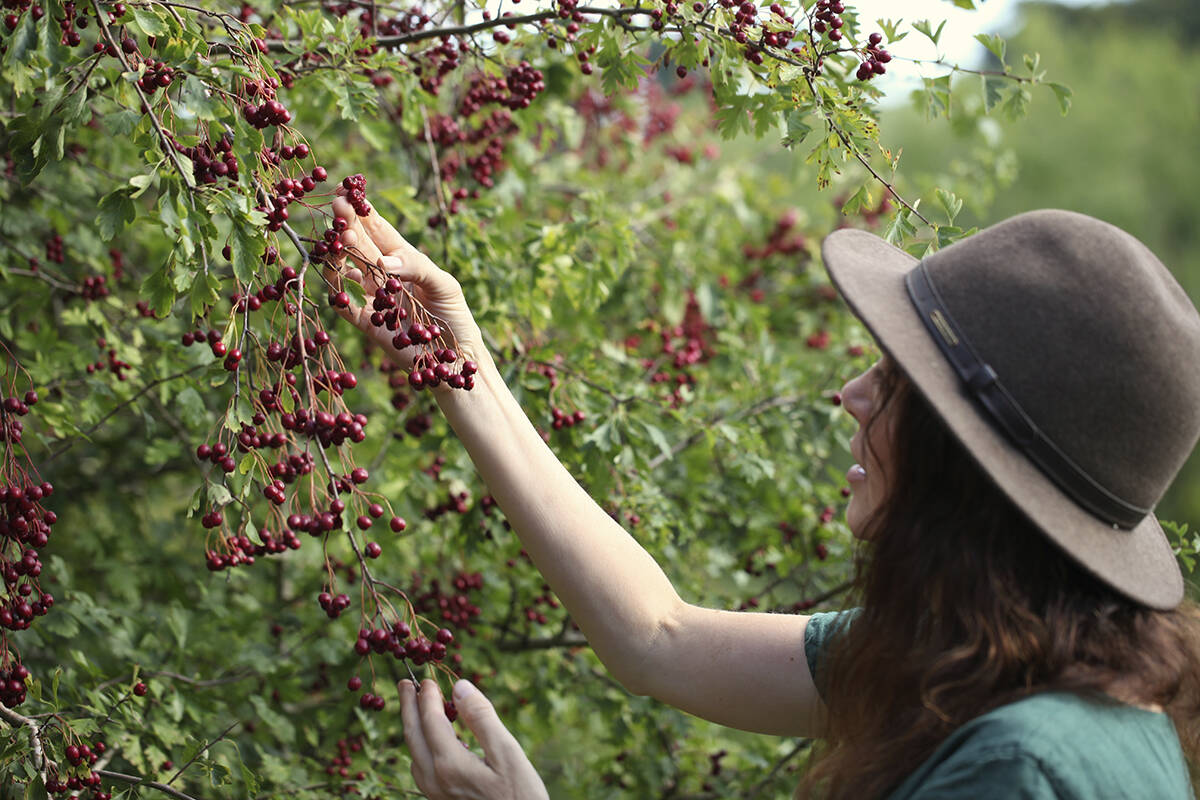Hawthorn’s heart-filled beauty meets us in each season. Tiny hand-shaped leaves reach out to greet us in spring, offering a wayside snack best eaten straight off the tree like a deer. In May, hawthorn’s blossom, soft and white with a little pink, covers the hedgerows and the forests, releasing a musty sweet scent that ignites two things within the mind – sex and death with notes of decay, fertility and desire. Flies, drawn to feast on the dark rot and unravelling of bodies, are attracted to its flowers, as are the bees and pollinators so in love with the sweet nectar. This duality massively increases hawthorn’s ability to thrive.
Branches of blossom were used to represent fertility, growth and new journeys in the pre-Christian May festival, Beltane. Through its medicine, this small tree teaches us the importance of being connected to the heart when stepping into new ways, while also mirroring the opposing steps of fertility and decay needed when we long to grow: through releasing and letting rot what holds us back and composting all we are not, we create the fecund womb of what will be.
We see this process reflected strongly back at us at this time of year, for autumn’s great unravelling is upon us. Nature is letting go of previous forms, enabling seeds to be fed and nourished. At this time of year, hawthorn brings forth bright red berries that hang in clusters from the branches like drops of heart blood. When eating the pectin-filled flesh of the berry around the large pip within, you may notice it tastes subtly of apple with hints of avocado.
The whole tree, especially the berries, provides a cardiotonic herb, helpful for all kinds of heart concerns and circulation. The leaves, blossom and fruit, a deeply beautiful medicine for the physical and emotional heart, have been shown to support cardiac function and are said to help with palpitations, grief, heartbreak, bone-deep sadness and anxiety. They protect the physical heart, relax and soothe the central nervous system, and help ease emotional edges and pain. By softening and nourishing the heart space, hawthorn can bring a sense of safety and wholeness – if you feel in need of a hug, turn towards hawthorn.
A member of the Rosaceae family, hawthorn has beautiful, strong thorns, which provide a refuge of protection to a variety of birds. This adaptation also shelters the young trees from deer, enabling them to grow and giving hawthorn the name ‘forest midwife’. For us humans, the thorns illustrate the importance of boundaries if we wish to feel safe enough to be in our hearts. Hawthorn teaches that this doesn’t mean becoming weaker. In fact, it means quite the opposite, for in inhabiting our hearts, we more readily know ourselves. Hawthorn helps us honour who we truly are at our core. Matching both strength and softness, it shows us the innate, wild ability to cultivate healthy boundaries as well as gentleness.
Brigit Anna McNeill will speak at the 'Nature as a healer' trilogy of talks in November. resurgenceevents.org
Hawthorn overnight infusion
Let hawthorn’s heart-healthy benefits infuse into you. The hawthorn can be dried, used fresh or a combination of both.
Ingredients
1 tbsp hawthorn leaf
1 tbsp hawthorn blossom
1 tbsp hawthorn berry
500ml water
a 500ml glass jar, warmed
Method
Add the hawthorn leaf, flower and berry to the jar. Pour just-boiled water over, filling the jar to within one inch of the top, and screw on the lid. Let the infusion sit overnight or for at least 10 hours. Strain in the morning to separate the hawthorn from the infused water. Enjoy throughout the day at room temperature, or warm gently to taste.
Hedgerow hawthorn fruit leather
Ingredients
1kg wild, foraged berries – around 500g of these should be pectin-rich hawthorn berries
100–200ml water
1–2 tbsp honey (optional)
Method
Place the fruit and water in a large pan. Add the lid and simmer for 15–20 minutes, until the fruit is soft and mashable. Add a little extra water if needed, but don’t let it get too runny – you want to end up with a purée. Once the fruit is soft, mash it up well. Place a sieve over a bowl and pour the fruit mix into the sieve. Rub the pulp through the sieve and discard the seeds and skins. At this stage the pulp should be the consistency of custard. If it looks watery, return it to a clean pan and simmer gently to evaporate off some more of the water content and thicken the mix. Taste the pulp. If you’d like it sweeter, mix in the honey while still warm.
Line baking trays with baking paper. Pour the fruit pulp into them and place in a dehydrator or in an oven on the lowest possible setting with the door left ajar. The pulp can take anything from 2 to 8 hours to dry. If you are using an oven, you do not need to keep it on for the entire time. We like to alternate between an hour on and an hour off, being sure to leave the oven door open a bit to let moisture escape. When the pulp is dry to the touch, cut it into 4cm strips and roll it up in greaseproof paper. Store it in the fridge for up to two weeks or freeze it for up to a year.








